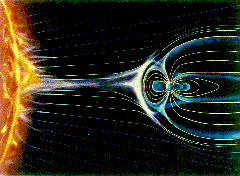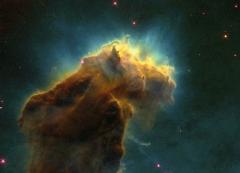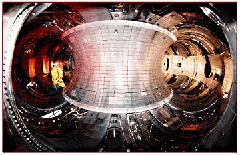 |
|
+ Home | ||

|
||||
| + Solar Cycle Prediction | + Magnetograph | + The Sun in Time | + The Hinode Mission | + The STEREO Mission |
Why We Study The Sun
|
The Climate Connection
The Sun is a source of light and heat for life on Earth. Our ancestors
realized that their lives depended upon the Sun and they held the Sun in reverent awe. We
still recognize the importance of the Sun and find the Sun to be awe inspiring. In
addition we seek to understand how it works, why it changes, and how these changes
influence us here on planet Earth. The Sun was much
dimmer in its youth and yet the Earth
was not frozen. The quantity and quality of light from the Sun varies on time scales
from milli-seconds to billions of years.
During recent sunspot cycles the
total solar irradiance has changed by about 0.1% with the sun being
brighter at sunspot maximum. Some of these variations most certainly affect our
climate but in uncertain ways. | ||
|
Space Weather
The Sun is the source of the solar wind; a flow
of gases from the Sun that streams past the Earth at speeds of more than 500 km per second
(a million miles per hour). Disturbances in the solar wind shake the Earth's magnetic
field and pump energy into the radiation belts. Regions on the surface of the Sun often flare and give off ultraviolet light and x-rays that heat up the
Earth's upper atmosphere. This "Space Weather" can change the orbits of
satellites and shorten mission lifetimes. The excess radiation can physically damage
satellites and pose a threat to astronauts. Shaking the Earth's magnetic field can also
cause current surges in power lines that destroy equipment and knock out power over large
areas. As we become more dependent upon satellites in space we will increasingly feel the
effects of space weather and need to predict it. | ||
|
The Sun as a Star
The Sun also serves an important role in helping us to understand the rest
of the astronomical universe. It is the only star close enough to us to reveal details
about its surface. Without the Sun we would not have easily
guessed that other stars also have spots and hot outer atmospheres. The Sun is the key to
understanding other stars. We know the Sun's age, radius, mass, and luminosity
(brightness) and we have also learned detailed information about its interior and
atmosphere. This information is crucial for our understanding of other stars and how they
evolve. Many physical processes that occur elsewhere in the universe can be examined in
detail on the Sun. In this way solar astronomy teaches us much about stars, planetary
systems, galaxies, and the universe itself. | ||
|
The Sun as a Physical LaboratoryThe Sun produces its energy by nuclear fusion - four hydrogen nuclei are fused to form single helium nuclei deep within the Sun's core. We have worked for decades to reproduce this process (in a controlled manner) here on Earth. Most of these efforts involve extremely hot plasmas in strong magnetic fields. (This plasma is not the blood product but rather a mixture of ions and electrons produced at high temperatures.) Much of solar astronomy involves observing and understanding plasmas under similar conditions. There continues to be much interaction between solar astronomers and scientific researchers in this and many other areas. |
|
||||||||||||||||||||||||||||



